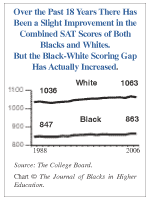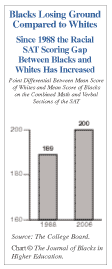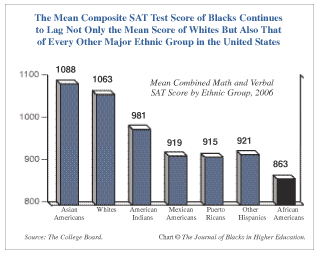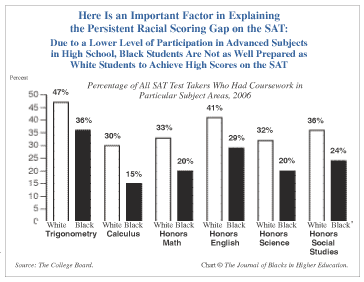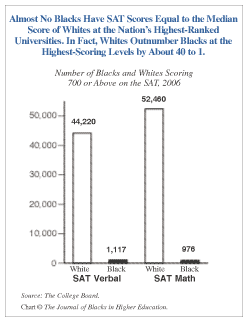| A Large Black-White Scoring Gap Persists on the SAT In 2006 The College Board reported the largest drop in SAT scores in over 30 years. But lost in the publicity surrounding this news was the good news that the racial scoring gap on the SAT actually grew smaller, albeit by a small amount.In 2006 average scores on the SAT (formerly known as the Scholastic Assessment Test) for students of all races dropped by the largest margin in more than 30 years. Everywhere this news generated headlines. But largely obscured by the overall scoring decline was the fact that the racial scoring gap actually grew somewhat smaller. Here we present our annual analysis on racial differences in scoring results on the SAT college admissions test. In order to make a legitimate comparison with past SAT results, we will ignore, for the moment, test results on the new writing component of the SAT. This new part of the SAT is viewed with skepticism by admissions officials at scores of prestigious colleges and universities.
In 2006 the average black score on the combined math and verbal portions of the SAT test was 863. The mean score for whites on the combined math and verbal SAT was 1063, about 17 percent higher. Not only are African-American scores on the SAT far below the scores of whites and Asian Americans, but they also trail the scores of every other major ethnic group in the United States including students of Puerto Rican and Mexican backgrounds. In fact, few people realize that American Indian and Alaska Native students on average score 118 points higher than the average score of black students. On average, Asian American students score 225 points, or 19 percent, higher than African Americans. Trend in the Racial Scoring Gap The racial gap in SAT scores this year actually declined by a slight margin from a year ago. But over the past decade the racial scoring gap has increased. In 1976 The College Board published an analysis of the racial differences in scores on what was then called the Scholastic Aptitude Test (SAT). At that time the average black score was about 240 points, or 20 percent, below the average white score. By the early 1980s, the gap had shrunk to 200 points. Black scores were then 17 percent lower than the scores of whites. By 1988 the black-white SAT test scoring gap was down to 189 points. The trend was distinctly encouraging. Many specialists in the educational community predicted that in time the racial scoring gap between blacks and whites would disappear altogether. But after 1988, progress in closing the SAT gap stopped abruptly and later it began to open up. The 189 point racial scoring gap in 1998 has grown as high as 204 points and this year sits at 200 points. These are persisting statistics that best tell the story of how deep the academic achievement gulf is between African Americans and the rest of the American population. Explaining the Black-White Scoring Gap on the SAT Test A number of reasons are advanced to explain the large and persisting black-white SAT scoring gap. Sharp differences in family incomes are a major factor. Always there has been a direct correlation between family income and SAT scores. For both blacks and whites, as income goes up, so do test scores.
In 2006, 24 percent of all black SAT test takers were from families with annual incomes below $20,000. Only 4 percent of white test takers were from families with incomes below $20,000. At the other extreme, 8 percent of all black test takers were from families with incomes of more than $100,000. The comparable figure for white test takers was 31 percent. But there is a major flaw in the thesis that income differences explain the racial gap. Consider these observable facts from The College Board�s 2006 data on the SAT: • Whites from families with incomes of less than $10,000 had a mean SAT score of 993. This is 130 points higher than the national mean for all blacks.
Other Explanations for the Racial Scoring Gap on the SAT Clearly, one of the main factors in explaining the SAT racial gap is that black students almost across the board are not being adequately schooled to perform well on the SAT and similar tests. Public schools in many neighborhoods with large black populations are underfunded, inadequately staffed, and ill equipped to provide the same quality of secondary education that is offered in predominantly white suburban school districts. Data from The College Board shows that 59 percent of white students who took the SAT were ranked in the top 20 percent of their high school classes. This compares to 39 percent of black test takers. Some 48 percent of white students who took the SAT report that their high school grade point average was in the A range. This compares to only 24 percent of black test takers. The mean high school grade point average for all white students who took the SAT was 3.40. For blacks, the figure was 3.01. These figures alone explain a large portion of the racial scoring gap on the SAT. A major reason for the SAT racial gap appears to be explained by the fact that black students who take the SAT have not followed the same academic track as white students. It is true that 97 percent of both blacks and whites who take the SAT have studied algebra in high school. But in higher level mathematics courses such as trigonometry and calculus, whites hold a very large lead. In 2006, 47 percent of white SAT test takers had taken trigonometry in high school compared to 36 percent of black test takers. Some 30 percent of white test takers had taken calculus in high school. Only 15 percent of black students had taken calculus, one half as many as whites. Thirty-three percent of white SAT test takers had taken honors courses in mathematics compared to 20 percent of black SAT test takers.
Similar discrepancies appear in the level of instruction in English, the other major component of the SAT. Some 90 percent of white test takers had completed coursework in American literature compared to 80 percent of black test takers. For whites, 67 percent had taken high school courses in composition compared to 52 percent of blacks. Some 71 percent of whites and 61 percent of blacks had completed coursework in grammar. A full 41 percent of all white test takers had completed honors courses in English compared to 29 percent of black test takers. Also, whites are far more likely than blacks to have taken honors courses in science and social studies. Given the huge differences in course study between black and white high school students, it comes as no surprise that white SAT scores are significantly higher than black SAT scores. Whites, who are more likely to attend high-quality schools, have simply achieved a greater mastery of the subject matter than have blacks. There are other reasons that contribute to the large scoring gap between blacks and whites on the SAT: • In some, if not many, cases, black schoolchildren are taught by white teachers who have low opinions of the abilities of black kids from the moment they enter the classroom. These teachers immediately write off black students as academic inferiors and do not challenge them sufficiently to achieve the skills necessary to perform well on standardized tests.
Almost No Blacks Among the Top Scorers on the SAT Test It is important to explain how the SAT racial scoring gap challenges affirmative action policies at the nation�s highest-ranked colleges and universities. Under the SAT scoring system, most non-minority students hoping to qualify for admission to any of the nation�s 25 highest-ranked universities and 25 highest-ranked liberal arts colleges need to score at least 700 on each portion of the SAT.
For admission to the very highest ranked, brand-name schools such as Princeton or MIT, applicants need scores of 750 to be considered for admission. Yet, as we shall see, only a minute percentage of black test takers score at these levels. Thus, if high-ranking colleges and universities were to abandon their policies of race-sensitive admissions, they will be choosing their first-year students from an applicant pool in which there will be practically no blacks. Let�s be more specific about the SAT racial gap among high-scoring applicants. In 2006, 150,643 African Americans took the SAT test. They made up 10.3 percent of all SAT test takers. But only 976 African-American college-bound students scored 700 or above on the math SAT and only 1,117 scored at least 700 on the verbal SAT. Nationally, more than 95,000 students of all races scored 700 or above on the math SAT and nearly 69,000 students scored 700 or above on the verbal SAT. Thus, in this top-scoring category of all SAT test takers, blacks made up only 1 percent of the students scoring 700 or higher on the math test and only 1.6 percent of the students scoring 700 or higher on the verbal SAT. If we eliminate Asians and other minorities from the statistics and compare just white and black students, we find that 5.4 percent of all white SAT test takers scored 700 or above on the verbal portion of the test. But only 0.74 percent of all black SAT test takers scored at this level. Therefore, whites were nearly seven times as likely as blacks to score 700 or above on the verbal SAT. Overall, there are more than 39 times as many whites as blacks who scored at least 700 on the verbal SAT. On the math SAT, only 0.6 percent of all black test takers scored at least 700 compared to 6.4 percent of all white test takers. Thus, whites were more than 10 times as likely as blacks to score 700 or above on the math SAT. Overall, there were more than 53 times as many whites as blacks who scored 700 or above on the math SAT.
In a race-neutral competition for the approximately 50,000 places for first-year students at the nation�s 25 top-ranked universities, high-scoring blacks would be buried by a huge mountain of high-scoring non-black students. Today, under prevailing affirmative action admissions policies, there are about 3,000 black first-year students matriculating at these 25 high-ranking universities, about 6 percent of all first-year students at these institutions. But if these schools operated under a strict race-neutral admissions policy where SAT scores were the most important qualifying yardstick, these universities could fill their freshman classes almost exclusively with students who score at the very top of the SAT scoring scale. As shown previously, black students make up at best between 1 and 2 percent of these high-scoring groups. The Racial Gap on the SAT Writing Test Now let�s look at the racial gap on the new writing component of the SAT. The mean black score on the writing section in 2006 was 428. For whites, the mean score was 519. Therefore, the gap on the writing portion of the SAT is slightly smaller than on the verbal portion of the SAT and significantly smaller than the racial gap on the mathematics section of the SAT. Many observers believed that the introduction of the writing component would, by design, lessen the racial scoring gap in order to deflect criticism of The College Board. It is probable that in some instances the people who score the new writing section will be able to detect the race of the writer by the vocabulary and subject matter of the student�s essay. There is then a suspicion in some quarters that the scorers of the test may be inclined to �give a break� to black students. Therefore, it is suggested that the examination is graded on a curve that benefits blacks and Hispanics. Looking to the Future In the Grutter case upholding affirmative action in college admissions, Justice Sandra Day O�Connor�s decision expressed the goal of eliminating affirmative action over the next 25 years. At the moment there is no evidence that substantial progress toward closing the racial scoring gap on the SAT test will occur. A new study by The College Board based on family income trends estimates that there will still be a large racial gap in standardized test scores 22 years from now, the deadline for race-sensitive admissions as outlined by Justice O�Connor. Thus, the huge and growing gap in SAT scores, and particularly the scores at the highest levels, becomes one of the nation�s most urgent problems. | |




